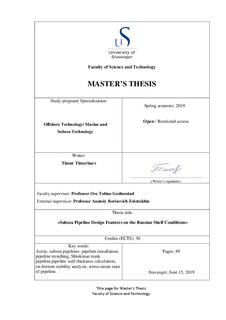| dc.description.abstract | Today in Russia, more than 75% of the explored onshore oil and gas fields are involved in the development, and their reserves have been produced at least by half. New discovered deposits are less and less, and their resources are several times less than 20-30 years ago. Discovered, but not developed, offshore fields, by contrast, are classified as large or even giant [32]. Therefore, Russian oil and gas companies are facing the task of sharply intensifying their activities on the shelf in the near future.
During the development of offshore fields, one of the main issues is the choice of transportation method of the extracted products. Today, hydrocarbons are transported either by tanker or by pipeline. For several reasons, preference is given to pipelines: the offshore pipeline, unlike a tanker, allows uninterrupted supply of hydrocarbons to the shore, regardless of weather conditions, and in addition, ship accidents are more dangerous than on pipelines.
All Russian oil and gas shelves are located in freezing seas of Arctic. The region of the Arctic seas, is characterized by its harsh climatic and hydrometereological conditions, which require a special approach in the design of subsea pipelines.
This thesis discusses the main features in the construction of underwater pipelines in the conditions of the Russian Arctic region. Also in Master thesis such stages of designing subsea pipelines as the choice of the minimum wall thickness of the pipeline, the determination of the required thickness of the weighting concrete coating are shown. In addition, the analysis of the stress-strain state of the pipeline during its installation is conducted. The calculations were carried out evidence from the trunk pipeline for the Shtokman gas condensate field (SCGF – Teriberka). | nb_NO |
